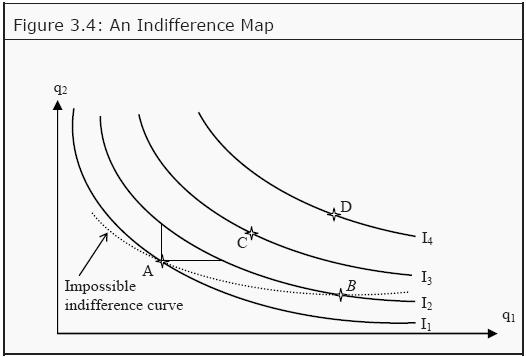Indifference Maps
Indifference Maps Assignment Help | Indifference Maps Homework Help
Indifference Maps
Since the preferences are complete, some indifference curve must run through each point, i.e. each basket. If we randomly choose four baskets, A, B, C, and D, there will be some indifference curve that runs through each point (see Figure 3.4).If we move to the northeast in the diagram, the level of utility increases. Labeling the indifference curves I1, I2, I3, and I4, they must therefore represent higher and higher levels of utility. A collection of several indifference curves in one figure is called an indifference map. It is common to compare indifference maps to elevation contours on a regular map: It is like walking up or down a hill when one moves from one indifference curve to another. After we have drawn the indifference curves, we can also compare points that do not lie to the northeast or southwest of each other. In the figure, point B is not to the northeast of point A, but it does lie on an indifference curve that is “higher” than the one that runs through A. Consequently, point B represents a basket that is better than the one represented by point A. We can also see this in the following way: Note that there are points on I2 that lie to the northeast of point A (between the two dotted lines that originate at A). Those points must therefore be better than A. Moreover, all points on I2 are equally good for the individual (since she, by definition, is indifferent between all of them). Consequently, point B represents a level of utility that is exactly the same as the points on I2 that are to the northeast of A. Therefore, B must be better than A is. Note that if we argue that way, we have used the assumption of transitivity.

The indifference curves have the following four important properties:
1- Baskets that are further away from the origin (the point (0,0) in the graph) are better than the ones closer to the origin.
2- Every point has an indifference curve that runs through it, since the preferences are complete.
3- Indifference curves cannot cross each other. This follows from the assumptions of transitivity and non-satiation.
4- The indifference curves slope downwards. If they would slope upwards, we would violate the assumption of non-satiation.